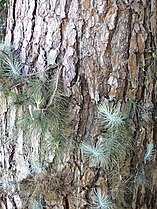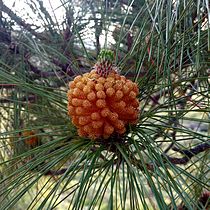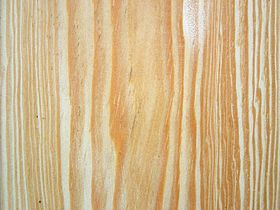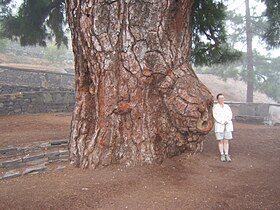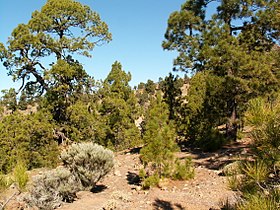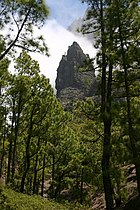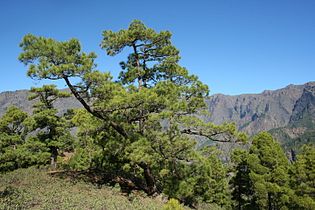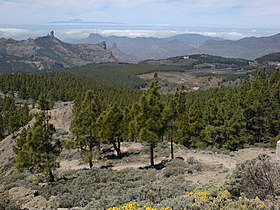Pinus canariensis
| Pinus canariensis Canary Island pine | |
|---|---|

| |
| Canary Island pines in Caldera de Taburiente, La Palma | |
| Scientific classification | |
| Kingdom: | Plantae |
| Clade: | Tracheophytes |
| Clade: | Gymnospermae |
| Division: | Pinophyta |
| Class: | Pinopsida |
| Order: | Pinales |
| Family: | Pinaceae |
| Genus: | Pinus |
| Subgenus: | P. subg. Pinus
|
| Section: | P. sect. Pinus
|
| Subsection: | Pinus subsect. Pinaster
|
| Species: | P. canariensis
|
| Binomial name | |
| Pinus canariensis | |
Pinus canariensis, the Canary Island pine, is a species of
Description
Pinus canariensis is a large
Taxonomy
Pinus canariensis was first described in 1825 by Augustin Pyramus de Candolle, who attributed the name to Christen Smith.[2][4] It has been placed in subsection Pinaster of subgenus Pinus, section Pinus. The other species in the subsection are mainly Mediterranean in distribution, with one species (P. roxburghii) from the Himalayas.[5]
Distribution and habitat
The species is native and
The native range has been somewhat reduced due to over-cutting so that only the islands of Tenerife, La Palma and Gran Canaria still have large forests. Really big trees are still rare due to past over-cutting.[1] It is the tallest tree in the Canary Islands.
Fossil record
Fossils of Pinus canariensis have been described from the fossil flora of Kızılcahamam district in Turkey which is of early Pliocene age.[6] Fossil cones including seeds of Pinus canariensis are known from the late Miocene of Abkhazia, from the Vienna Basin and the Canary Islands. Numerous cone casts including seeds of Pinus canariensis from the early Pleistocene, were recovered on Kallithea, Rhodes.[7]
Ecology
This pine is one of the most fire-resistant conifers in the world, due to several beneficial adaptations.[8][9][10] In particular, Pinus canariensis is one of the few pine species that can epicormically resprout after losing its needles in a fire.[11]
Uses
The tree's extremely long needles make a significant contribution to the islands' water supply, trapping large amounts of condensation from the moist air coming off the Atlantic with the prevailing north eastern wind (locally called "alisios"). The condensation then drops to the ground and is quickly absorbed by the soil, eventually percolating down to the underground aquifers.[citation needed]
The aromatic
In mainland Spain, South Africa, Sicily and Australia, it has become a naturalized species from original landscape uses.
Pinus canariensis is a popular
In culture
It is the vegetable symbol of the island of La Palma.[12]
Gallery
-
In natural habitat on Canary Islands
-
Trunk
-
Epicormic shoots
-
A cluster of mature male cones of a Pinus canariensis in Gran Canaria
-
Mature opened female cone
-
Figure on timber
-
Fire-resistant trunk
-
Vilaflor, Tenerife
-
Tenerife south
-
Pinus canariensis, Santa Cruz
-
Pinus canariensis forest, La Palma
-
Pinus canariensis Caldera de Taburiente
-
Tenerife
-
Gran Canaria
-
Male cones of Pinus canariensis photographed in Temecula, CA, USA
-
Ayacata, San Bartolomé de Tirajana, Gran Canaria, Canary Islands, Spain.
-
seedling in La Talleta, Tenerife, Canary Islands
See also
References
- ^ . Retrieved 2021-11-19.
- ^ a b "Pinus canariensis C.Sm. ex DC.". The International Plant Names Index. Retrieved 2021-08-26.
- ^ ISBN 978-0-85199-539-7.
- ^ "Pinus canariensis C. Sm. ex DC.". Tropicos. Missouri Botanical Garden. Retrieved 2021-08-26.
- JSTOR 25065300.
- ^ Kasaplıgil, Baki (1977). "Ankara, Kızılcahamam yakınındaki Güvem köyü civarında bulunan son tersiyer kozalaklı-yeşil yapraklı ormanı" [A Late-Tertiary Conifer-Hardwood Forest From the Vicinity of Güvem Village, Near Kızılcahamam, Ankara] (PDF). Bulletin of the Mineral Research and Exploration (in Turkish and English). 88. Ankara: General Directorate of Mineral Research and Exploration: 94–102.
- - DOI:10.1127/palb/291/1994/131 by Zlatko Kvacek, Vasilis Teodoridi, Petr Mazouch and Paul Roiron
- ^ "The most fire-resistant pine in the world • Forest Monitor". Forest Monitor. 9 January 2017. Retrieved 2022-09-23.
- ^ Starexcursions; Starexcursions (26 December 2016). "The canary island pine resists fire: how is it possible?". StarExcursions. Retrieved 2022-09-23.
- ^ https://nature.berkeley.edu/stephenslab/wp-content/uploads/2015/04/Molina-et-al.-Canary-Island-FH-FEM-10-16.pdf [bare URL PDF]
- PMID 23110592.
- ^ Símbolos de la naturaleza para las Islas Canarias [Natural Symbols for the Canary Islands] (Ley 7/1991) (in Spanish). Vol. 151. 30 April 1991. pp. 20946–20497 – via BOE.




